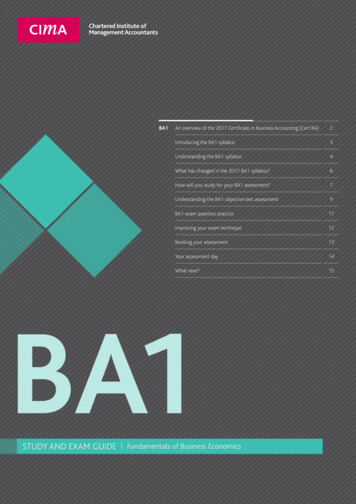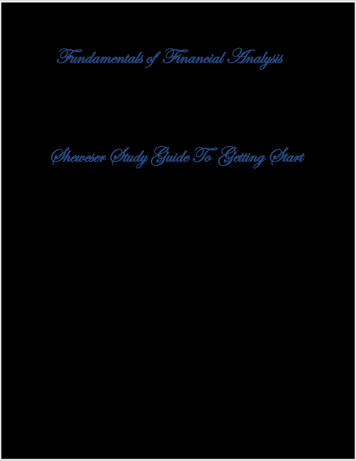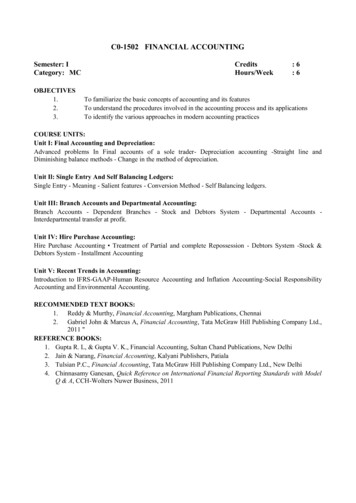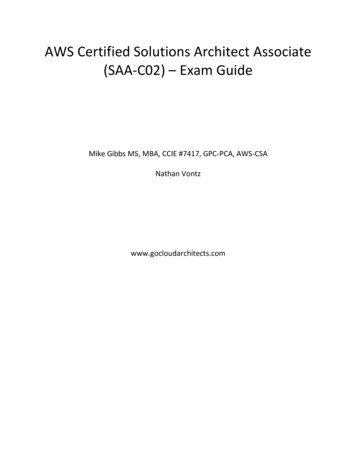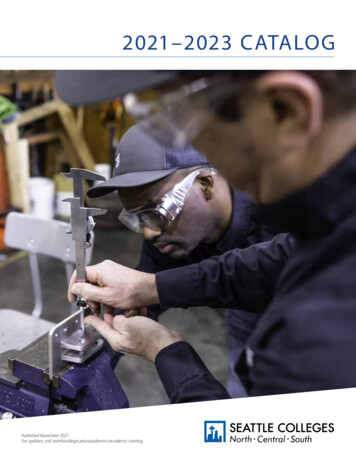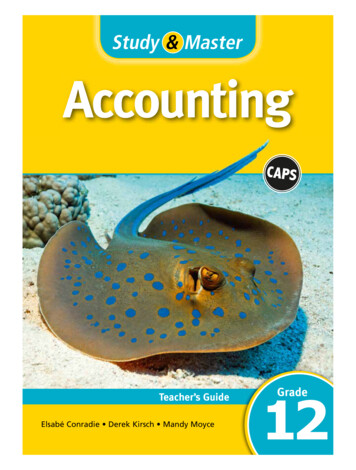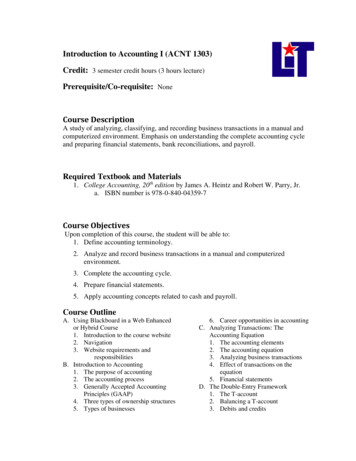
Transcription
C02-Fundamentals of financial accountingSample Exam PaperQuestion 1The difference between an income statement and an income and expenditure account isthat:A. An income and expenditure account is an international term for an Income statement.B. An income statement is prepared for a business and an income and expenditureaccount is prepared for a not-for-profit making organisation.C. An income statement is prepared on an accruals basis and an income andexpenditure account is prepared on a cash flow basis.D. An income statement is prepared for a manufacturing business and an income andexpenditure account is prepared for a non-manufacturing business.Question 2Which one of the following sentences does NOT explain the distinction between financialaccounts and management accounts?A. Financial accounts are primarily for external users and management accounts areprimarily for internal users.B. Financial accounts are normally produced annually and management accounts arenormally produced monthly.C. Financial accounts are more accurate than management accounts.D. Financial accounts are audited by management where as management accounts areaudited by external auditors.Question 3Which one of the following should be accounted for as capital expenditure?A.B.C.D.Cost of painting a building.The replacement of windows in a building.The purchase of a car by a garage for re-sale.Legal fees incurred on the purchase of a building.Question 4A company includes in inventory goods received before the year end, but for which invoicesare not received until after the year end. This is in accordance withA. The historical cost convention.B. The accruals concept.C. The consistency concept.Updated: Oct 20131
C02-Fundamentals of financial accountingD. The materiality concept.Question 5When there is inflation, the historical cost convention has the effect ofA.B.C.D.Overstating profits and understating statement of financial position values.Understating profits and overstating statement of financial position values.Understating cash flow and overstating cash in the statement of financial position.Overstating cash flow and understating cash in the statement of financial positionQuestion 6Which ONE of the following best describes the stewardship function?A.B.C.D.Ensuring high profits.Managing cash.Ensuring the recording, controlling and safeguarding of assets.Ensuring high dividends to shareholders.Question 7The accounting equation at the start of the month was:Assets 14,000 less liabilities 6,500.During the following month, the business purchased a non-current asset for 6,000, payingby cheque, a profit of 9,000 was made, and payables of 7,500 were paid by cheque.What would the balance on capital be at the end of month?Question 8Non-current assets can best be defined as Items of machinery which are not moveable andare purchase with an intention of resale.True/FalseQuestion 9The objective of financial statements is it enables users to assess the performance ofmanagement and to aid in decision making.True/falseQuestion 10The core objective of accounting isA.B.C.D.Provide financial information to the users of such informationMaintain records of assets and liabilitiesKeep record or transactionsTo fulfil statutory requirementsUpdated: Oct 20132
C02-Fundamentals of financial accountingQuestion 11B operates the imprest system for petty cash. At 1 July there was a float of 150, but it wasdecided to increase this to 200 from 1 August onwards. During July, the petty cashierreceived 25 from staff for using the photocopier and a cheque for 90 was cashed for anemployee. In July, cheques were drawn for 500 for petty cash.What was the total expense paid from petty cash in July?A.B.C.D. 385. 435. 515. 615.Question 12Z’s bank statement shows a balance of 825 overdrawn. The bank statement includes bankcharges of 50, which have not been entered in the cash book. There are unpresentedcheques totalling 475 and deposits not yet credited of 600. The bank statement incorrectlyshows a direct debit payment of 160, which belongs to another customer.What figure for the bank balance should be shown in the statement of financial position?A.B.C.D. 590 overdrawn. 540 overdrawn. 790 overdrawn. 840 overdrawn.Question 13What is an imprest system?A.B.C.D.Records the use of a company’s seal.Helps to reconcile the cash book with the bank statement.Helps to control petty cash.Is part of computerised accounting?Question 14The entries in a sales ledger control account are:SalesBankSales returnsBad debts (irrecoverable debts?)Returned unpaid chequeContra with purchase ledger account 250,000 225,000 2,500 3,000 3,500 4,000What is the balance on the sales ledger control account?Updated: Oct 20133
C02-Fundamentals of financial accountingA.B.C.D. 12,000 19,000 25,000 27,000Question 15P is a sole proprietor whose accounting records are incomplete. All the sales are cash salesand during the year 50,000 was banked, including 5,000 from the sale of a business car.He paid 12,000 wages in cash from the till and withdrew 2,000 per month as drawings.The cash in the till at the beginning and end of the year was 300 and 400 respectively.What were the sales for the year?A.B.C.D. 80,900 81,000 81,100 86,100Question 16N operates an imprest system for petty cash. On 1 February, the float was 300. It wasdecided that this should be increased to 375 at the end of February.During February, the cashier paid 20 for window cleaning, 100 for stationery and 145 forcoffee and biscuits. The cashier received 20 from staff for the private use of thephotocopier and 60 for a miscellaneous cash sale.What amount was drawn from the bank account for petty cash at the end of February?A.B.C.D. 185 260 315 375Question 17On 1 May, East owed a supplier 1,200. During the month of May, East: Purchased goods for 1,700 and the supplier offered a 5% discount for payment within themonth. Returned goods valued at 100 which had been purchased in April. Sent a cheque to the supplier for payment of the goods delivered in May.What is the balance on the supplier’s account at the end of May?A.B.C.D. 1,015 1,100 1,185 1,300Updated: Oct 20134
C02-Fundamentals of financial accountingQuestion 18North, which is registered for sales tax, received an invoice from an advertising agency for 4,000 plus sales tax. The rate of sales tax on the goods was 20%.What would the correct ledger entries be?Debit A.B.C.D.Credit Advertising expense 4,000 Payables 4,000Advertising expense 4,800 Payables 4,800Advertising expense 4,800 Payables 4,000 Sales tax account 800Advertising expense 4,000 Payables 4,800 Sales tax account 800Question 19Which of the following are used in a coding system for accounting transactions?A.B.C.D.Department code.Nominal ledger code.Product code.All of the above.Question 20Which ONE of the following attributes is the most important for any code to possess in orderto be of use in an accounting system?A.B.C.D.Easy to change the code number.Each code is a unique number.A combination of letters and digits to ensure input accuracy.Linked to assets, liabilities, income, expenditure and capital.Question 21On 1 May, A pays a rent bill of 1,800 for the twelve months to 30 April. What is thecharge/credit to the income statement for the year ended 30 November?Question 22A car was purchased for 12,000 on 1 April in year 1 and has been depreciated at 20% eachyear straight line, assuming no residual value. The company policy is to charge a full year’sdepreciation in the year of purchase and no depreciation in the year of sale. The car wastraded in for a replacement vehicle on 1 August in year 4 for an agreed figure of 5,000.What was the profit or loss on the disposal of the vehicle in year 4?Updated: Oct 20135
C02-Fundamentals of financial accountingQuestion 23The following information relates to M:At 30 SeptemberYear 2 000Inventories:Raw materialsWork-in-progressFinished goods7560100Year 1 000457090For the year ended 30 September Year 2Purchases of raw materialsManufacturing wagesFactory/production overheads 150,00050,00040,000What is the prime cost of production in the manufacturing account for year 2?Question 24A company bought a machine on 1 October year 1 for 52,000. The machine had anexpected life of eight years and an estimated residual value of 4,000. On 31 March year 6,the machine was sold for 35,000. The company’s yearend is 31 December. The companyuses the straight-line method for depreciation and it charges a full year’s depreciation in theyear of purchase and none in the year of sale.What is the profit or loss on disposal of the machine?A.B.C.D.Loss 13,000Profit 7,000Profit 10,000Profit 13,000Question 25N purchased a machine for 15,000. The transportation costs were 1,500 and installationcosts were 750. The machine broke down at the end of the first month in use and cost 400to repair. N depreciates machinery at 10% each year on cost, assuming no residual value.What is the net book value of the machine after one year?A.B.C.D. 13,500 14,850 15,525 15,885Question 26Updated: Oct 20136
C02-Fundamentals of financial accountingB made an issue of 150,000 1 ordinary shares at a premium of 20% the proceeds of whichis received by cheque.What is the correct journal to record this?A. BankShare capitalShare premiumDr 180,000Cr 150,000 30,000B. BankShare premium 180,000C. BankShare capital 180,000D. BankShare premiumShare capital 150,000 180,000 180,000 30,000 120,000Question 27APM provides the following note to non-current assets in its statement of financial position.Plant and machineryOpening balanceAdditions/chargeDisposalsClosing balanceCost 0002515(10)30Depreciation 000124(8)8Net book value 0001311(2)22The additional machinery was purchased for cash. A machine was sold at a profit of 2,000.What is the net cash outflow for plant and machinery?A.B.C.D. 9,000 11,000 13,000 15,000Question 28Which ONE of the following expenses should be included in prime cost in a manufacturingaccount?A.B.C.D.Repairs to factory machinery.Direct production wages.Office salaries.Factory insurance.Updated: Oct 20137
C02-Fundamentals of financial accountingQuestion 29SSG bought a machine for 40,000 in January year 1. The machine had an expected usefullife of six years and an expected residual value of 10,000. The machine was depreciated onthe straight-line basis where a full year’s charge in made in the year of purchase and none inthe year of sale. In December year 4, the machine was sold for 15,000. The company has apolicy in its internal accounts of combining the depreciation charge with the profit or loss ondisposal of assets. Its year end is 31 December.What is the total amount of profit/loss charged to the income statement over the life of themachine?A.B.C.D. 15,000 20,000 25,000 30,000Question 30At the beginning of the year GHI, had opening work-in-progress of 240,000. During theyear, the following expenditure was incurred: Prime cost720,000Factory/production overheads72,000Closing work-in-progress350,000What was the factory/production cost of goods completed during?A.B.C.D. 538,000 610,000 682,000 902,000Question 31In July year 1, a company sold goods at VAT rate with a net value of 200,000, goodsexempt from VAT with a value of 50,000 and goods at zero VAT rate with a net value of 25,000.The purchases in July year 1, which were all subject to VAT, were 161,000, including VAT.Assume that the rate of VAT is 15%.The difference between VAT input tax and VAT output tax isA.B.C.D.Dr 9,000Cr 5,850Cr 9,000None of theseUpdated: Oct 20138
C02-Fundamentals of financial accountingQuestion 32S purchased equipment for 80,000 on 1 July year 1. The company’s accounting year end is31 December. It is S‘s policy to charge a full year’s depreciation in the year of purchase. Sdepreciates its equipment on the reducing balance basis at 25% per annum.What is the net book value of the equipment at 31 December year 4?A.B.C.D.Nil 25,312 29,531 33,750Question 33H began trading on 1 July. The company is now preparing its accounts for the accountingyear ended 30 June year 1. Rent is charged for the year from 1 April to 31 March, and was 1,800 for the year ended 31 March year 1 and 2,000 for the year ended 31 March year 2.Rent is payable quarterly in advance, plus any arrears, on 1 March, 1 June, 1 Septemberand 1 December.The charge to H ‘S income statement for rent for the year ended 30 June year 2 isA.B.C.D. 1,650 1,700 1,850 1,900Question 34The following information related to Q for the year ended 28 February: For use Prime costFactory/production overheadsOpening work-in-progressFactory cost of goods completed122,000185,00040,000300,000What is the closing work-in-progress for Q?Question 35The profit of a business may be calculated by using which one of the following formulae?A.B.C.D.Opening capital - drawings capital introduced - closing capitalClosing capital drawings - capital introduced - opening capitalOpening capital drawings - capital introduced - closing capitalClosing capital - drawings capital introduced - opening capitalUpdated: Oct 20139
C02-Fundamentals of financial accountingQuestion 36On 1 June year 1, H paid an insurance invoice of 2,400 for the year to 31 May year 2. Whatis the charge to the income statement and the entry in the financial statement for the yearended 31 December year 1?A.B.C.D. 1,000 income statement and prepayment of 1,400. 1,400 income statement and accrual of 1,000. 1,400 income statement and prepayment of 1,000. 2,400 income statement and no entry in the statement of financial position.Question 37The following information at 5 January year 3 relates to a club, which has a year end of 31December year 2: Subscriptions for year 1 unpaid at January year 2300Subscriptions for year 1 paid during the year ended 31 December year 2250Subscriptions for year 2 paid during the year ended 31 December year 26,000Subscriptions for year 3 paid during the year ended 31 December year 21,000Subscriptions for year 2 unpaid at 31 December year 2750It is the club’s policy to write off overdue subscriptions after one year.What amount should be credited to the income and expenditure account for 31 Decemberyear 2?A.B.C.D. 6,250 6,750 7,050 7,250Question 38On the first day of Month 1, a business had prepaid insurance of 10,000. On the first day ofMonth 8, it paid, in full, the annual insurance invoice of 36,000, to cover the following year.What is the amount charged in the income statement and the prepayment shown in thestatement of financial position at the year end?A.B.C.D.Updated: Oct 2013IS SFP 5,00022,00025,00036,00024,00023,00021,00015,00010
C02-Fundamentals of financial accountingQuestion 39SAD paid 240,000 in net wages to its employees in August. Employees’ tax was 24,000,employees’ national insurance was 12,000 and employer’s national insurance was 14,000. Employees had contributed 6,000 to a pension scheme and had voluntarily askedfor 3,000 to be deducted for charitable giving.What is the amount of wages expense to be charged to the income statement in August?A.B.C.D. 285,000 293,000 296,000 299,000Question 40Which ONE of the following formulae correctly expresses the relationship between the returnon capital employed (ROCE), net profit margin (NPM) and asset turnover (AT)?A.B.C.D.ROCE NPM ATROCE NPM ATROCE NPM x ATROCE NPM – ATQuestion 41An increase in inventories of 500 and a decrease in the bank balance of 600 and anincrease in payables of 1,400 results in:A.B.C.D.A decrease in working capital of 1,500An increase in working capital of 1,500A decrease in working capital of 1,300An increase in working capital of 1,300Question 42The turnover of a company was 4 million and its receivables were 7.5% of turnover. Thecompany wishes to have an allowance of 3% of receivables, which would result in anincrease of 25% of the current allowance. What figure would appear in the income statementfor bad debts?Question 43The following information was extracted from the balance sheets of ABC at 31 DecemberYear 2 and at 31 December Year 1:Year 1Updated: Oct 2013Year 211
C02-Fundamentals of financial accountingStockDebtorsTrade creditorsother creditors 00010014012055 00012017514075What figure should appear as part of the cash flow statement for the year ended 31December 2002?A.B.C.D. 25,000 outflow 15,000 outflow 15,000 inflow 25,000 inflowQuestion 44What is the fundamental objective of an external audit of a limited company?A.B.C.D.Give advice to shareholders.Detect fraud and errors.Measure the performance and financial position of a company.Provide an opinion on the financial statements.Question 45Which one of the following statements most closely expresses the meaning of “true and fairpresentation”?A.B.C.D.There is only one true and fair presentation of a company’s financial statements.True and fair presentation is determined by compliance with accounting standards.True and fair presentation is determined by compliance with company law.True and fair presentation is largely determined by reference to generally acceptedaccounting practice.Question 46What is the principal duty of an external auditor?A. To confirm that financial statements give fair presentation.B. To ensure that a company’s systems and controls are adequate to ensure thereliability of the accounting records.C. To prevent fraud and errors.D. To provide a report to the shareholders.Question 47Which ONE of the following provides the best explanation of the objective of an internalaudit?Updated: Oct 201312
C02-Fundamentals of financial accountingA. The objective is to assist directors of a company in the effective discharge of theirfinancial responsibilities towards the members.B. The objective is to provide support to the external auditor.C. The objective is to detect fraud and error.D. The objective is to audit the financial statements.Question 48Which of the following best describes the role of the internal auditor?A.B.C.D.Auditing the financial accounts.Supporting the work of the external auditors.Reporting to management on the accounting systems.Ensuring value for money.Question 49Which of the following errors will cause the trial balance totals to be unequal?A.B.C.D.Errors of transposition.Errors of omission.Errors of principle.All of the above.Question 50An error of commission occurs where the entries required for a transaction are partiallyomitted.True/FalseUpdated: Oct 201313
C02-Fundamentals of financial 930313233343536373839BAC 16,500FalseFalseAABCBCBBDDB 1,050 200 170,000DCABBCCCBC 47,000BCBDD4344454647484950Updated: Oct 2013AnswerAADebit 1,800BDAAACAFalse14
C02-Fundamentals of financial accountingExplanations:1. Principle difference between Income Statement and Income & Expenditure Account.2.Principle knowledge about the usage and preparation of Financial Accounts andManagement Accounts.3. Option A, B & C are the examples of revenue expenditure. Capital expenditure is thefunds used to acquire or upgrade the physical assets.4.Principle knowledge of Accruals concept.5.Principle knowledge of historical cost convention.6.Principle knowledge of stewardship function.7. 16,500Assets Capital LiabilitiesAssets Capital14,0007,500 0(7,500)16,500(1,000)8.FalseNon current assets are the assets acquired with a going concern view.9.FalseThe users of financial statements are external stake holders who do not necessarilyadvise the management on the decision making and to address the operationalissues of the company.10. Principle knowledge of accounting.Updated: Oct 201315
C02-Fundamentals of financial accounting11.1st July FloatCash from staffCheque for employeeCheques drawn for petty cashAmount paid in to petty cash X1st August Balance maintained 150 25 ( 90) 500 ( 385) 20012.Over drawnUn presented chequesIncorrect direct debitDeposits not creditedOver drawn in SOFP(825)(475)160600 54013. Principle knowledge of petty cash Imprest system. One of the advantages of havingimprest system in place.14.Sales Ledger ControlSalesDis HonChqB/FAccount250,000 Bank3,500 00015.Total cash during the yearBanked 50,000Paid wages 12,000With drew cash 24,000Difference betweenOpening and closing 100Total cash 86,100 Less cash deposited from car sale 5000 Sales 81,80016.O/BWindow cleaningUpdated: Oct 2013 300 (20)16
C02-Fundamentals of financial accountingStationeryCoffee and biscuitsPhotocopy revenueMiscellaneous receivedBank AmountC/B (100) (145) 20 60 260 37517.owing moneyGood receivedGood returnedCheques PresentedDiscountNet balance 1200 1700 (100) (1615) (85) 110018.Expenses are recorded excluding the VAT there fore we will have expenses as perthe gross amount 4000 and sales VAT separately however the total payables will be 4800.19. Principle knowledge of coding accounting systems.20. Principle knowledge of coding accounting systems.21. 1050Rent Per month 1,800/12 150No of months May to Nov 7Charge to IS 7x 150 105022. 200Car Value 12,000End year 1 Value 12,000- 2400 9600End year 2 Value 9,600-2400 7200End year 3 Value 7200- 2400 4800Year 4 carrying Value 4,800 Less sale price 5000 profit 200.23. 170,000Prime cost DM DLMaterial O/B 45,000Material Purchase 150,000Material C/B %75,000Total Material Consumer 45,000 150,000-75,000 120,000Direct Manufacturing wages 50,000Prime cost 120,000 50,000 170,000Updated: Oct 201317
C02-Fundamentals of financial accounting24. Machine Value 52,000Residual Value 4000Estimated life 8 yearsstraight line depreciation each year over a 8 year life 6,000Machine sold in year 6 for 35,000Book Value year 6 52,000-30000 22000Profit Sale – Book Value 35,000-22,000 13,000.25. Total value of asset is 15,000 1500 750 17,25010% deprecation for the year 1725Book value at the end of year 15,525Repairing cost of 400 does not adds up to the value of asset.26. Bank is debited with the actual amount received Share capital and Share premiumare credited individually.27. ( 11,000)1. Additional machinery purchased on cash cash outflow 15,0002. NBV of the asset disposed 2,0003. Profit on Asset disposed 2,000Total cash from sales 4,000Net cash flow - 15,000 4,000 ( 11,000)28. Principle knowledge of prime cost.29. Machine cost 40,000Estimated life 6 yearsResidual Value 10,000Depreciation straight lineYear 4 selling price 15,000NBV year 4 40,000- 15,000 25,000Profit/loss Loss 10,000 15,000 of depreciation as per internal policy30. O/B 240,000Prime cost 720,000Over heads 72,000C/B 350,000Total cost of finished goods O/B Prime cost over heads –C/B 240,000 720,000 72,000-350,000 682,00031. VAT received by customer is 30,000 VAT paid by the company 21,000Purchase made 161,000 inclusive of VAT gross purchase 161,000/1.15 give 15%rate of Vat.32. Reducing balance methodYear1 end value 8,000x75% 60,000Updated: Oct 201318
C02-Fundamentals of financial accountingyear 2 end value 60,000x75% 45,500Year 3 end value 45,000x75% 33,750year 4 end value 33,750x75% 2531233. 1,800x9/12 2,000x3/12 1,85034. 47,000Goods complete cost O/B Prime cost Overheads – closing balance.300,000 40,000 122,000 185,000 –C/B300,000-347,000 -C/B-47,000 -C/B47,000 C/B35. Principle knowledge of Accounting equation.36. 2,400/12X7 charge to IS 2,400/12x5 SOFP as prepayment37. The subscription charged for year 2. 6000 750 6750. Ignoring the paid datesand recognizing on the issuing date.38. Charge to income statement is balance brought forward 5/12 of 36,000prepayments 7/12 of 36,00039. D40. C41. Increase in inventory increase in working capitaldecrease in Bank decrease in working capitalIncrease in payables decrease in working capital 500-600-1400 Total decrease of 1500 in working capital.42. Debit 1800TR 4,000,000 % of receivables 7.5%Amount for receivables 300,000Provision for bad debts 3% of receivables 9,000Increase in provision is 25% more than previous year Previous provision 9,000/1.25 7,200 9000- 7200 1800 Debit income statement.43. B 15,000 outflowCash flow from working capital activities.Updated: Oct 201319
C02-Fundamentals of financial accountingIncrease in Trade creditors Increase in other creditors Less Increase in stock Increase in debtors. (20 20) - (20 35) (15)44. Principle knowledge of an external audit.45. The “true and fair presentation” is an opinion and can vary within certain parametersso there can be more than a single true and fair presentation of a company’s financialstatements.46. Principle knowledge of external audit.47. Principle knowledge of internal audit.48. One of the primary functions of an internal auditor is to report on the currentaccounting systems, evaluate the reliability of the system and identify the loop holesin the current accounting system.49. All the mentioned above accounting error result in an equal trail balance as theyeffect the different accounting heads but not the sides of each entry. What usuallycauses the trail balance to be unequal are arithmetic errors that is when you sum upeach side or the wrong amounts for one but not both entries in the trial balance.50. FalseAn error of commission occurs where a correct amount is entered, but in the wrongperson s account.Updated: Oct 201320
Z's bank statement shows a balance of 825 overdrawn. The bank statement includes bank charges of 50, which have not been entered in the cash book. There are unpresented cheques totalling 475 and deposits not yet credited of 600. The bank statement incorrectly shows a direct debit payment of 160, which belongs to another customer.

